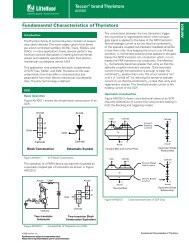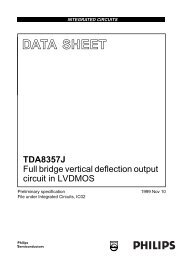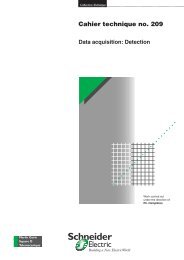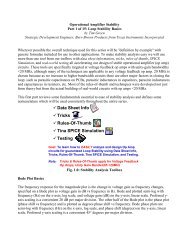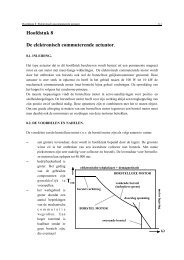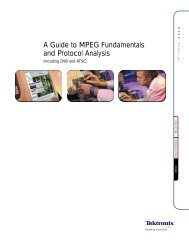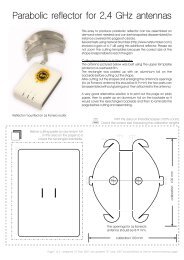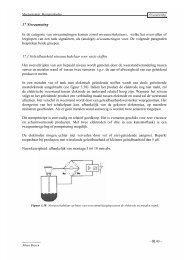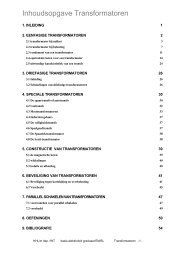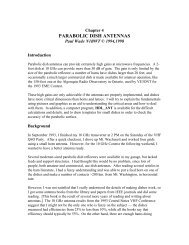Determining MOSFET Driver Needs for Motor Drive ... - Microchip
Determining MOSFET Driver Needs for Motor Drive ... - Microchip
Determining MOSFET Driver Needs for Motor Drive ... - Microchip
You also want an ePaper? Increase the reach of your titles
YUMPU automatically turns print PDFs into web optimized ePapers that Google loves.
M AN898<br />
Author: Jamie Dunn<br />
<strong>Microchip</strong> Technology Inc.<br />
INTRODUCTION<br />
Electronic motor control <strong>for</strong> various types of motors<br />
represents one of the main applications <strong>for</strong> <strong>MOSFET</strong><br />
drivers today. This application note discusses some of<br />
the fundamental concepts needed to obtain the proper<br />
<strong>MOSFET</strong> driver <strong>for</strong> your application.<br />
The bridging element between the motor and <strong>MOSFET</strong><br />
driver is normally in the <strong>for</strong>m of a power transistor. This<br />
can be a bipolar transistor, <strong>MOSFET</strong> or an Insulated<br />
Gate Bipolar Transistor (IGBT). In some small<br />
Brushless DC motor or stepper motor applications, the<br />
<strong>MOSFET</strong> driver can be used to directly drive the motor.<br />
For this application note, though, we are going to<br />
assume that a little more voltage and power capability<br />
is needed than what the <strong>MOSFET</strong> drivers can handle.<br />
The purpose of motor speed control is to control the<br />
speed, direction of rotation or position of the motor<br />
shaft. This requires that the voltage applied to the<br />
motor is modulated in some manner. This is where the<br />
power-switching element (bipolar transistor, <strong>MOSFET</strong>,<br />
IGBT) is used. By turning the power-switching elements<br />
on and off in a controlled manner, the voltage<br />
applied to the motor can be varied in order to vary the<br />
speed or position of the motor shaft. Figures 1<br />
through 5 show diagrams of some typical drive configurations<br />
<strong>for</strong> DC Brush, DC Brushless, Stepper, Switch<br />
Reluctance and AC Induction motors.<br />
+<br />
V SUPPLY<br />
-<br />
<strong>Determining</strong> <strong>MOSFET</strong> <strong><strong>Drive</strong>r</strong> <strong>Needs</strong> <strong>for</strong><br />
<strong>Motor</strong> <strong>Drive</strong> Applications<br />
<strong>Motor</strong><br />
FIGURE 1: <strong>Drive</strong> Configuration <strong>for</strong> a DC<br />
Brush <strong>Motor</strong>.<br />
V SUPPLY<br />
FIGURE 2: <strong>Drive</strong> Configuration <strong>for</strong> a DC<br />
Brushless <strong>Motor</strong>.<br />
FIGURE 3: <strong>Drive</strong> Configuration <strong>for</strong> a<br />
4-Wire Stepper <strong>Motor</strong>.<br />
© 2003 <strong>Microchip</strong> Technology Inc. DS00898A-page 1<br />
+<br />
-<br />
+<br />
VSUPPLY -<br />
<strong>Motor</strong><br />
<strong>Motor</strong>
AN898<br />
+<br />
VSUPPLY -<br />
<strong>Motor</strong><br />
FIGURE 4: <strong>Drive</strong> Configuration <strong>for</strong> Each<br />
Winding of a Switch Reluctance <strong>Motor</strong>.<br />
+<br />
VSUPPLY -<br />
<strong>Motor</strong><br />
FIGURE 5: <strong>Drive</strong> Configuration <strong>for</strong> an<br />
AC Induction <strong>Motor</strong>.<br />
TABLE 1: MOTOR RATINGS<br />
<strong>Motor</strong> Type<br />
Horse<br />
Power<br />
Rating<br />
(HP)<br />
Voltage<br />
Rating<br />
Current Rating (A)<br />
Full<br />
Load<br />
Locked<br />
Rotor<br />
As seen in Figures 1 through 5, even though the motor<br />
type changes, the purpose of the drive circuitry is to<br />
provide voltage and current to the windings of the<br />
motor. The voltage and current level will vary<br />
depending on what type and size of motor is being<br />
used, but the fundamentals of selecting the powerswitching<br />
element and the <strong>MOSFET</strong> driver are the<br />
same.<br />
SELECTING THE POWER-<br />
SWITCHING ELEMENT<br />
The first stage in selecting the correct power-switching<br />
element <strong>for</strong> your motor drive application is<br />
understanding the motor being driven. Understanding<br />
the ratings of the motor is an important step in the<br />
process as it is often the corner points of operation that<br />
will determine the choice of the power switching<br />
element. A sample of motor ratings <strong>for</strong> the motor types<br />
listed earlier is shown in Table 1. When dealing with<br />
motors, it is often useful to remember that 1 Horse<br />
Power (HP) is equal to 746 Watts.<br />
From the ratings in Table 1, the voltage, current and<br />
power ratings vary significantly with the different types<br />
of motors. <strong>Motor</strong> ratings can also vary significantly<br />
within the same motor type. A key point to note in<br />
Table 1 is the value of the start-up current (sometimes<br />
given as stall current or locked-rotor current). The<br />
startup current value can be up to three times the value<br />
of the steady-state operating current. As mentioned<br />
previously, it is these corner points of operation that will<br />
determine the necessary ratings of the drive element.<br />
Because of the various voltage and current ratings <strong>for</strong><br />
the various motor types, the selected drive device<br />
ratings will have to vary as well, depending on the<br />
application and design goals.<br />
Efficiency<br />
(%)<br />
Power<br />
Factor<br />
Slip<br />
Factor<br />
Torque<br />
lb*ft<br />
Full Load<br />
RPM<br />
DC Brushless 0.54 48 VDC 8.7 120 87 NA NA 0.53 5000<br />
DC Brush 0.40 60 VDC 6.0 106 84 NA NA 0.70 4000<br />
Stepper 0.01 24 VDC 0.3 1.0 65 NA NA 0.1 300 to 600<br />
Switch Reluctance 1.20 24 VDC 37.5 NG 94 NA NA 1.8 15,000<br />
AC Induction 2.00 230 VAC 10.0 65.0 79 0.81 1.15 3.0 3450<br />
DS00898A-page 2 © 2003 <strong>Microchip</strong> Technology Inc.
<strong>MOSFET</strong> OR IGBT, WHAT’S BEST<br />
FOR YOUR APPLICATION?<br />
The two main choices <strong>for</strong> power-switching elements <strong>for</strong><br />
motor drives are the <strong>MOSFET</strong> and IGBT. The bipolar<br />
transistor used to be the device of choice <strong>for</strong> motor<br />
control due to it’s ability to handle high currents and<br />
high voltages. This is no longer the case. The <strong>MOSFET</strong><br />
and IGBT have taken over the majority of the applications.<br />
Both the <strong>MOSFET</strong> and IGBT devices are voltage<br />
controlled devices, as opposed to the bipolar transistor,<br />
which is a current-controlled device. This means that<br />
the turn-on and turn-off of the device is controlled by<br />
supplying a voltage to the gate of the device, instead of<br />
a current. This makes control of the devices much<br />
easier.<br />
G<br />
N-Channel<br />
<strong>MOSFET</strong><br />
D<br />
S<br />
N-Channel<br />
IGBT<br />
FIGURE 6: <strong>MOSFET</strong> and IGBT<br />
Symbols.<br />
The similarities between the <strong>MOSFET</strong> and the IGBT<br />
end with the turn-on and turn-off of the devices being<br />
controlled by a voltage on the gate. The rest of the<br />
operation of these devices is very different. The main<br />
difference being that the <strong>MOSFET</strong> is a resistive<br />
channel from drain-to-source, whereas the IGBT is a<br />
PN junction from collector-to-emitter. This results in a<br />
difference in the way the on-state power dissipations<br />
are calculated <strong>for</strong> the devices. The conduction losses<br />
<strong>for</strong> these devices are defined as follows:<br />
<strong>MOSFET</strong><br />
P<br />
2<br />
LOSS = Irms * RDS-ON<br />
where:<br />
RDS-ON = drain-to-source on-state resistance<br />
Irms = drain-to-source rms current<br />
IGBT<br />
PLOSS = Iave * VCE-SAT VCE-SAT = collector-to-emitter saturation voltage<br />
Iave = collector-to-emitter average current<br />
G<br />
C<br />
E<br />
AN898<br />
The key difference seen in these two equations <strong>for</strong><br />
power loss is the squared term <strong>for</strong> current in the<br />
<strong>MOSFET</strong> equation. This requires the RDS-ON of the<br />
<strong>MOSFET</strong> to be lower, as the current increases, in order<br />
to keep the power dissipation equal to that of the IGBT.<br />
In low voltage applications, this is achievable as the<br />
RDS-ON of <strong>MOSFET</strong>s can be in the 10’s of milli-ohms.<br />
At higher voltages (250V and above), the RDS-ON of<br />
<strong>MOSFET</strong>s do not get into the 10’s of milli-ohms.<br />
Another key point when evaluating on-state losses is<br />
the temperature dependence of the RDS-ON of the<br />
<strong>MOSFET</strong> versus the VCE-SAT of an IGBT. As<br />
temperature increases, so does the RDS-ON of the<br />
<strong>MOSFET</strong>, while the VCE-SAT of the IGBT tends to<br />
decrease (except at high current). This means an<br />
increase in power dissipation <strong>for</strong> the <strong>MOSFET</strong> and a<br />
decrease in power dissipation <strong>for</strong> the IGBT.<br />
Taking all of this into account, it would seem that the<br />
IGBT would quickly take over the applications of the<br />
<strong>MOSFET</strong> at higher voltages, but there is another<br />
element of power loss that needs to be considered.<br />
That is the losses due to switching. Switching losses<br />
occur as the device is turned on and off with current<br />
ramping up or down in the device with voltage from<br />
drain-to-source (<strong>MOSFET</strong>) or collector-to-emitter<br />
(IGBT). Switching losses occur in any hard-switched<br />
application and can often dominate the power losses of<br />
the switching element.<br />
The IGBT is a slower switching device than the<br />
<strong>MOSFET</strong> and, there<strong>for</strong>e, the switching losses will be<br />
higher. An important point to note at this juncture is that<br />
as IGBT technology has progressed over the past 10<br />
years, various changes have been made to improve<br />
the devices with different applications. This is also true<br />
of <strong>MOSFET</strong>s, but even more so <strong>for</strong> IGBTs. Various<br />
companies have multiple lines of IGBTs. Some are<br />
optimized <strong>for</strong> slow-speed applications that have lower<br />
VCE-SAT voltages, while others are optimized <strong>for</strong><br />
higher-speed applications (60 kHz to 150 kHz) that<br />
have lower switching losses, but have higher VCE-SAT voltages. The same is true <strong>for</strong> <strong>MOSFET</strong>s. Over the past<br />
5 years, a number of advances have been made in<br />
<strong>MOSFET</strong> technology which have increased the speed<br />
of the devices and lowered the RDS-ON . The net result<br />
of this is that, when doing a comparison between IGBTs<br />
and <strong>MOSFET</strong>s <strong>for</strong> an application, make sure the<br />
devices being compared are best suited to the<br />
application. This assumes, of course, that the devices<br />
also fit within your budget.<br />
Although the IGBT is slower than the <strong>MOSFET</strong> at both<br />
turn-on and turn-off, it is mainly the turn-off edge that is<br />
slower. This is due to the fact that the IGBT is a minority<br />
carrier recombination device in which the gate of the<br />
device has very little effect in driving the device off (will<br />
vary depending on the version of the IGBT, fast, ultrafast,<br />
etc.). This can be seen in the equivalent circuit <strong>for</strong><br />
the IGBT shown in Figure 7. When the gate is turned<br />
on (driven high), the N-channel <strong>MOSFET</strong> pulls low on<br />
© 2003 <strong>Microchip</strong> Technology Inc. DS00898A-page 3
AN898<br />
the base of the PNP transistor, effectively driving the<br />
device on. During turn-off, however, when the gate of<br />
the device is pulled low, only the minority carrier recombination<br />
of the device is effecting the turn-off speed. By<br />
varying some of the parameters of the device (such as<br />
oxide thickness and doping) the speed of the device<br />
can be changed. This is the essence of the various<br />
families of IGBTs that are available from multiple suppliers.<br />
Increases in speed often result in higher V CE-SAT<br />
voltages and reduced current ratings <strong>for</strong> a given die<br />
size.<br />
Gate<br />
Collector<br />
Emitter<br />
FIGURE 7: Equivalent Circuit <strong>for</strong> an<br />
IGBT.<br />
Calculating switching losses <strong>for</strong> IGBTs is not as<br />
straight<strong>for</strong>ward as it is <strong>for</strong> the <strong>MOSFET</strong>. For this reason,<br />
switching losses <strong>for</strong> IGBTs are typically characterized<br />
in the device data sheet. Switching losses are<br />
typically given in units of Joules. This allows the user to<br />
multiply the value by frequency in order to get power<br />
loss.<br />
Switching losses is the biggest limiting factor that keep<br />
IGBTs out of many high-voltage, high switching-frequency<br />
applications. Because of the relatively low<br />
modulation/switching frequencies of motor control<br />
applications (typically less than 50 kHz), the switching<br />
losses are kept in check and the IGBT is as good or<br />
better than the <strong>MOSFET</strong>.<br />
Since this application note does not cover all the pros<br />
and cons of <strong>MOSFET</strong>s versus IGBTs, listed below are<br />
other application notes written about this topic.<br />
• “IGBTs vs. HEXFET Power <strong>MOSFET</strong>s For<br />
Variable Frequency <strong>Motor</strong> <strong>Drive</strong>s”, AN980,<br />
International Rectifier.<br />
• “Application Characterization of IGBTs” (this one<br />
will help you apply the IGBT and understand the<br />
device), AN990, International Rectifier.<br />
• “IGBT Characteristics”. This one goes into the<br />
fundamentals of the IGBT and compares it with<br />
the <strong>MOSFET</strong>, AN983, International Rectifier.<br />
• “IGBT or <strong>MOSFET</strong>: Choose Wisely”. This one<br />
discusses the crossover region of applications<br />
based on voltage rating of the device and<br />
operating frequency, White Paper, International<br />
Rectifier.<br />
• “IGBT Basic II”. This application note covers IGBT<br />
basics and discusses IGBT gate drive design and<br />
protection circuits, AN9020, Fairchild<br />
Semiconductor.<br />
• Application Manual from Fuji Semiconductor <strong>for</strong><br />
their 3rd-Generation IGBT modules. This covers<br />
many topics from IGBT basics to current sharing.<br />
To summarize some of the discussion so far, some of<br />
the generally accepted boundaries of operation when<br />
comparing the IGBT and <strong>MOSFET</strong> are:<br />
• For application voltages < 250V, <strong>MOSFET</strong>s are<br />
the device of choice. In searching many IGBT<br />
suppliers, you will find that the selection of IGBTs<br />
with rated voltages below 600V is very small.<br />
• For application voltages > 1000V, IGBTs are the<br />
device of choice. As the voltage rating of the<br />
<strong>MOSFET</strong> increases, so does the RDS-ON and size<br />
of the device. Above 1000V, the RDS-ON of the<br />
<strong>MOSFET</strong> can no longer compete with the<br />
saturated junction of the IGBT.<br />
• Between the 250V and 1000V levels described<br />
above, it becomes an application-specific choice<br />
that revolves around power dissipation, switching<br />
frequency and cost of the device.<br />
When evaluating the <strong>MOSFET</strong> versus the IGBT <strong>for</strong> an<br />
application, be sure to look at the per<strong>for</strong>mance of the<br />
device over the entire range. As discussed previously,<br />
the resistive losses of the <strong>MOSFET</strong> increase with<br />
temperature, as do the switching losses <strong>for</strong> the IGBT.<br />
Other hints <strong>for</strong> design and derating are:<br />
• Voltage rating of the device is derated to 80% of<br />
its value. This would make a 500V <strong>MOSFET</strong><br />
usable to 400V. Any ringing in the drain-to-source<br />
voltage in an application should also be taken into<br />
account.<br />
• The maximum junction temperature of the device<br />
should not exceed 120ºC at maximum load and<br />
maximum ambient. This will prevent any thermal<br />
runaway. Some sort of overtemperature<br />
protection should also be incorporated.<br />
• Care should be taken in the layout of the printed<br />
circuit board to minimize trace inductance going<br />
to the leads of the motor from the drive circuitry.<br />
Board trace inductance and lead inductance can<br />
cause ringing in the voltage that is applied to the<br />
motors terminals. The higher voltages can often<br />
lead to breakdown in the motor insulation<br />
between windings.<br />
• The current rating <strong>for</strong> the switching element must<br />
also be able to withstand short circuit and start-up<br />
conditions. The start-up current rating of a motor<br />
can be three to six times higher than the steady<br />
state operating current.<br />
DS00898A-page 4 © 2003 <strong>Microchip</strong> Technology Inc.
GATE DRIVE SCHEMES<br />
The type of motor, power-switching topology and the<br />
power-switching element will generally dictate the<br />
necessary gate drive scheme. The two fundamental<br />
categories <strong>for</strong> gate drive are high-side and low-side.<br />
High-side means that the source (<strong>MOSFET</strong>) or emitter<br />
(IGBT) of the power element can float between ground<br />
and the high-voltage power rail. Low-side means the<br />
source or emitter is always connected to ground. An<br />
example of both of these types can be seen in a halfbridge<br />
topology, shown in Figure 8. In this<br />
configuration, Q 1 and Q 2 are always in opposite states.<br />
When Q 1 is on, Q 2 is off and vice-versa. When Q 1 goes<br />
from being off to on, the voltage at the source of the<br />
<strong>MOSFET</strong> goes from ground up to the high-voltage rail.<br />
This means that the voltage applied to the gate must<br />
float up as well. This requires some <strong>for</strong>m of isolated, or<br />
floating, gate drive circuitry. Q 2, however, always has<br />
its source or emitter connected to ground so the gate<br />
drive voltage can also be referenced to ground. This<br />
makes the gate drive much more simple.<br />
High-voltage Rail<br />
G<br />
G<br />
D<br />
Q1 S<br />
D<br />
Q2 S<br />
<strong>Drive</strong> Voltage<br />
To <strong>Motor</strong> Winding<br />
FIGURE 8: Example of a High Side (Q 1)<br />
and Low Side (Q 2) Gate <strong>Drive</strong> Requirement.<br />
Various schemes exist <strong>for</strong> high-side gate drive<br />
applications. These include single-ended or doubleended<br />
gate drive trans<strong>for</strong>mers, high-voltage bootstrap<br />
driver ICs, floating bias voltages and opto-isolator<br />
drive. Examples of these drive schemes are shown in<br />
Figures 9 through 12.<br />
The <strong>Microchip</strong> <strong>MOSFET</strong> drivers that are shown in<br />
Table 2 on page 15 fit a wide variety of applications<br />
using the gate drive schemes shown in Figures 9, 10<br />
and 12. The single output drivers, which have ratings of<br />
0.5A up to 9.0A, work well <strong>for</strong> the single-ended gate<br />
drive needs <strong>for</strong> the circuits in Figures 9 and 12. The<br />
dual output drivers provide an excellent solution <strong>for</strong> the<br />
gate drive solution shown in Figure 10. The selection<br />
process <strong>for</strong> the <strong>MOSFET</strong> drivers is discussed later in<br />
this application note.<br />
PWM or <strong>MOSFET</strong> <strong><strong>Drive</strong>r</strong> IC<br />
AN898<br />
FIGURE 9: Single-Ended Gate <strong>Drive</strong><br />
Trans<strong>for</strong>mer.<br />
FIGURE 10: Double-Ended Gate <strong>Drive</strong><br />
Trans<strong>for</strong>mer.<br />
FIGURE 11: High Voltage Bootstrap<br />
<strong><strong>Drive</strong>r</strong> IC.<br />
© 2003 <strong>Microchip</strong> Technology Inc. DS00898A-page 5<br />
V CC<br />
OUT<br />
GND<br />
PWM or <strong>MOSFET</strong> <strong><strong>Drive</strong>r</strong> IC<br />
V CC<br />
OUT A<br />
OUT B<br />
GND<br />
VCC<br />
PWM<br />
controller<br />
OUT1<br />
OUT2<br />
GND<br />
V BIAS<br />
HI<br />
LI<br />
VCC<br />
GND<br />
D 1<br />
Level-Shift<br />
VB<br />
HO<br />
VS<br />
LO<br />
COM<br />
High-voltage<br />
Rail<br />
To <strong>Motor</strong><br />
High-voltage<br />
Rail<br />
Cboot<br />
Q 1<br />
To<br />
<strong>Motor</strong><br />
Q 2<br />
Q1<br />
R GATE<br />
Q2
AN898<br />
V SUPPLY<br />
GND<br />
Bias<br />
Control<br />
Gate <strong>Drive</strong><br />
Signal<br />
FIGURE 12: Floating Bias Gate <strong>Drive</strong> Circuit.<br />
The gate drive trans<strong>for</strong>mer solutions shown in<br />
Figures 9 and 10 provide a number of good features.<br />
The first feature is that they solve the high-side drive<br />
problem. The drive winding(s) that drive the gate of the<br />
power <strong>MOSFET</strong>/IGBT can float at any potential (only<br />
limitations to this are the insulation ratings of the wire).<br />
The second feature is that it provides both a positive<br />
and negative gate drive voltage. As with any<br />
trans<strong>for</strong>mer, there must be volt-time balancing. With<br />
the solution shown in Figure 9, the capacitor, in series<br />
with the winding, is charged during the on time of the<br />
drive signal and then provides the negative bias/drive<br />
voltage to the trans<strong>for</strong>mer during the off time. This acts<br />
as the reset mechanism <strong>for</strong> the trans<strong>for</strong>mer and also<br />
the mechanism to provide the negative gate drive<br />
voltage to the power-switching element, which is often<br />
very useful and needed, if an IGBT is being used. If a<br />
<strong>MOSFET</strong> is being used as the switching element and<br />
the negative drive is not desired (negative drive often<br />
increases delay times), a few additional components<br />
can be added to the circuit to fix this issue, as shown in<br />
Figure 13. With the addition of the diode and N-channel<br />
FET (low voltage, small signal type FET), the main Nchannel<br />
<strong>MOSFET</strong> still sees the same positive level<br />
drive signal as be<strong>for</strong>e (minus a diode drop), but is<br />
clamped to zero volts during the off time. The diode<br />
blocks the negative bias that now turns on the small<br />
signal FET that clamps the gate-to-source voltage to<br />
zero.<br />
The second gate drive trans<strong>for</strong>mer drive configuration<br />
shown in Figure 10 is a double-ended type drive,<br />
meaning that the trans<strong>for</strong>mer is driven in both<br />
directions. This type of drive is often used <strong>for</strong> halfbridge<br />
and full-bridge topologies. The bidirectional<br />
drive, coupled with the dot polarity of the trans<strong>for</strong>mer,<br />
drives Q1 on and Q2 off and vice versa. If the duty<br />
cycles of the <strong>MOSFET</strong>s are modulated differently,<br />
Opto-isolator<br />
+Vdrive<br />
-Vdrive<br />
additional gate drive circuitry may be required to balance<br />
the volt-time of the trans<strong>for</strong>mer. The same<br />
negative bias-blocking circuitry shown in Figure 13 can<br />
also be used in the double-ended drive scheme.<br />
FIGURE 13: Removal of Negative <strong>Drive</strong><br />
Voltage.<br />
The other feature of the gate drive trans<strong>for</strong>mer is that it<br />
can be driven from the secondary side with ground referenced<br />
circuitry. This means that it can provide a high<br />
voltage isolation boundary and allow the drive circuitry<br />
(PWM and <strong>MOSFET</strong> driver) to be ground-referenced<br />
and near the control circuitry, which is typically on the<br />
secondary side. This makes interfacing between the<br />
small signal-sensing circuitry (temperature-sensing,<br />
feedback loops, shutdown circuits) and the PWM very<br />
easy. With the drive circuitry now ground-referenced,<br />
low-side <strong>MOSFET</strong> drivers can be used. This expands<br />
the selection of available devices and will reduce the<br />
cost of the driver.<br />
DS00898A-page 6 © 2003 <strong>Microchip</strong> Technology Inc.<br />
IN<br />
V CC<br />
V EE<br />
OUT<br />
High Voltage Rail<br />
To <strong>Motor</strong><br />
High-voltage<br />
Rail<br />
To <strong>Motor</strong>
The high-voltage half-bridge driver IC, shown in<br />
Figure 11, provides a solution to the high-side drive<br />
issue and does not require the user to have any<br />
knowledge of trans<strong>for</strong>mers. These types of ICs utilize<br />
high-voltage, level-shifting circuitry, in conjunction with<br />
a “bootstrap” capacitor, to provide the high-side gate<br />
drive. During the on-time of FET/IGBT Q2, the source/<br />
emitter of Q1 is at ground potential. This allows<br />
capacitor Cboot to be charged through diode D1 from<br />
the bias supply VBIAS . When Q2 is turned off and Q1 is<br />
turned on, the voltage at the source of Q1 begins to<br />
rise. The Cboot capacitor now acts as the bias source<br />
<strong>for</strong> the high-side drive portion of the driver and provides<br />
the current-to-charge the gate of Q1. The level shifting<br />
circuitry of the driver allows the high-side drive stage to<br />
float up with the source voltage of Q1 . These types of<br />
drivers are often rated to handle up to 600V (with<br />
respect to ground) on the high-side drive portion of the<br />
circuitry. One of the draw-backs to many of these types<br />
of drivers is the long propagation delay times between<br />
the input signal and the high-side drive turning on/off.<br />
This is a result of the level shifting circuitry. These<br />
delays can be between 500 nsec. and 1 µsec. This can<br />
cause problems <strong>for</strong> some higher-frequency<br />
applications as the delay times take up too much of the<br />
overall period. Though, <strong>for</strong> most motor drive<br />
applications that are operating below 50 kHz, it is not<br />
an issue.<br />
The circuit shown in Figure 12 is often used in very high<br />
power applications where IGBT/<strong>MOSFET</strong> modules are<br />
being used. In these applications, the IGBT modules<br />
are often located a slight distance from all of the control<br />
circuitry. This makes it difficult to bus the gate drive<br />
signal to the module as the inductance in the wires will<br />
cause ringing at the gate of the module. For this<br />
reason, the isolated bias circuit is often built on a<br />
separate PC card and mounted directly to the IGBT/<br />
<strong>MOSFET</strong> module. With this scheme, the only signal<br />
that needs to be brought to the module is the small<br />
signal line that drives the opto-isolator. This is more<br />
easily accomplished since there is less current flowing<br />
in this line.<br />
The negative bias is often required <strong>for</strong> these<br />
applications in order to keep the IGBT in the off state.<br />
This will be described more in the following sections<br />
that discuss the gate properties of the IGBT. Though<br />
this scheme does require much more circuitry, it does<br />
provide a very robust solution <strong>for</strong> driving large gate<br />
capacitances in high-power applications. The Vsupply voltage that feeds the flyback topology can be a low<br />
voltage or high voltage supply. A low voltage supply of<br />
10V or less will make the flyback design easier, as<br />
biasing of the control circuitry can be done directly off<br />
of this voltage. High voltage flyback ICs that<br />
incorporate the high voltage <strong>MOSFET</strong> and biasing<br />
circuitry are available, which make low-power flybacks<br />
like this one easy to design.<br />
<strong>MOSFET</strong> AND IGBT GATE<br />
PROPERTIES<br />
AN898<br />
As stated earlier, the <strong>MOSFET</strong> and IGBT are voltagecontrolled<br />
devices. Both devices are characterized in<br />
the same manner, with data sheets supplying values<br />
<strong>for</strong> Gate Threshold Voltages (voltage at which the drain<br />
to source/collector to emitter channels begin to<br />
conduct) and Total Gate Charge.<br />
Figures and show the Electrical Characteristics section<br />
of data sheets <strong>for</strong> a <strong>MOSFET</strong> and an IGBT device<br />
that are rated <strong>for</strong> 500V and 20A, and 600V and 20A,<br />
respectively.<br />
Some key differences in the Electrical Characteristics<br />
table when comparing <strong>MOSFET</strong>s and IGBTs are:<br />
• The gate threshold voltage <strong>for</strong> the IGBT is slightly<br />
higher than that of the <strong>MOSFET</strong>. For the two<br />
devices being compared, the IGBT is specified <strong>for</strong><br />
3.0V to 6.0V (min. to max) where the <strong>MOSFET</strong> is<br />
specified <strong>for</strong> 2.0V to 4.0V. For most power<br />
devices, these thresholds are fairly standard. A<br />
key difference between the two devices is the<br />
temperature dependency of the gate-to-emitter<br />
threshold <strong>for</strong> the IGBT. This is shown as the<br />
“Temperature Coefficient of Threshold Voltage” in<br />
the IGBT data sheet. For this particular device, it<br />
is 13 mV/ºC. So as the junction temperature of<br />
this device heats up to 125°C (100°C rise above<br />
the specification temperature <strong>for</strong> the 3.0V to 6.0V<br />
range), the new range <strong>for</strong> the gate threshold<br />
voltage becomes 1.7V to 4.7V. This will make the<br />
device more susceptible to transient conditions<br />
which try to turn the gate on when it is supposed<br />
to be off. This is often the reason why negative<br />
gate drive voltages are used with IGBTs.<br />
• In the “Conditions” column, note that <strong>for</strong> the IGBT<br />
many of the conditions are <strong>for</strong> a VGE of 15V where<br />
the <strong>MOSFET</strong> is <strong>for</strong> a VGS of 10V. This is <strong>for</strong> good<br />
reason. Even though both devices are rated <strong>for</strong><br />
±20V from gate-to-source/emitter, the <strong>MOSFET</strong>s<br />
operation does not really improve with gate<br />
voltages above 10V (RDS-ON of the device no<br />
longer decreases with an increase in gate<br />
voltage). This can be seen by looking at the<br />
<strong>MOSFET</strong> typical characteristic curves <strong>for</strong> Drainto-Source<br />
Current versus Drain-to-Source Voltage.<br />
There is very little difference between the<br />
curves once VGS is 10V and above. For the IGBT,<br />
the curve <strong>for</strong> Collector-to-Emitter Voltage versus<br />
Gate-to-Emitter Voltage show that the device’s<br />
capability to handle more current continues to<br />
increase as the gate voltage is raised above 10V.<br />
This is important to remember when doing a comparison<br />
between the two devices. Many of the<br />
gate drive devices available today have an upper<br />
operating limit of 18V. Running 15V on VCC leaves very little room <strong>for</strong> adding a negative bias<br />
<strong>for</strong> IGBT turn-off.<br />
© 2003 <strong>Microchip</strong> Technology Inc. DS00898A-page 7
AN898<br />
Static @ TJ = 25°C (unless otherwise speicified)<br />
Parameter Min. Typ. Max. Units Conditions<br />
V (BR)DSS Drain-to-Source Breakdown<br />
Voltage<br />
500 — — V VGS = 0V, ID = 250 µA<br />
∆V (BR)DSS/∆TJ Breakdown Voltage Temperature<br />
Coefficient<br />
— 0.61 — V/°C Reference to 25°C, ID = 1 mA<br />
RDS(on) Static Drain-to-Source<br />
On-Resistance<br />
— — 0.27 Ω VGS = 10V, ID = 12A<br />
VGS(th) Gate Threshold Voltage 2.0 — 4.0 V VDS = VGS. ID = 250 µA<br />
I DSS Drain-to-Source Leakage Current —<br />
—<br />
IGSS Gate-to-Source Forward Leakage — — 100 nA VGS = 30V<br />
Gate-to-Source Reverse Leakage — — -100 VGS = -30V<br />
Dynamic @ TJ = 25°C (unless otherwise specified)<br />
FIGURE 14: 500V, 20A <strong>MOSFET</strong> Electrical Characteristics Table.<br />
—<br />
—<br />
DS00898A-page 8 © 2003 <strong>Microchip</strong> Technology Inc.<br />
25<br />
250<br />
µA V DS = 500V, V GS = 0V<br />
V DS = 400V, V GS = 0V, T J = 125°C<br />
Parameter Min. Typ. Max. Units Conditions<br />
gFS Forward Transconductance 11 — — S VDS = 50V, ID = 12A<br />
Qg Total Gate Charge — — 105 nC ID = 20A<br />
VDS = 400V<br />
VGS = 10V, See Figures 6 and 13.<br />
Qgs Gate-to-Source Charge — — 26<br />
Qgd Gate-to-Drain (“Miller”) Charge — — 42<br />
td(on) Turn-on Delay Time — 18 — ns VDD = 250V<br />
tr td(off) tr Rise Time<br />
Turn-off Delay Time<br />
Fall Time<br />
—<br />
—<br />
—<br />
55<br />
45<br />
39<br />
—<br />
—<br />
—<br />
ID = 20A<br />
RG = 4.3W<br />
RD = 13W, See Figure 10.<br />
Ciss Input Capacitance — 3100 — pF VGS = 0V<br />
Coss Crss Ouput Capacitance<br />
Reverse Transfer Capacitance<br />
—<br />
—<br />
480<br />
18<br />
—<br />
—<br />
VDS = 25V<br />
ƒ = 1.0 MHz, See Figure 5.<br />
Coss Ouput Capacitance — 4430 — VGS = 0V, VDS = 1.0V, ƒ = 1.0 MHz<br />
Coss Ouput Capacitance — 130 — VGS = 0V, VDS = 400V, ƒ = 1.0 MHz<br />
Coss eff. Effective Ouput Capacitance — 140 — VGS = 0V, VDS = 0V to 400V<br />
Avalanche Characteristics<br />
Parameter Typ. Max. Units<br />
EAS Single Pulse Avalanche Energy — 960 mJ<br />
IAR Avalanche Current — 20 A<br />
EAR Repetitive Avalanche Energy — 28 mJ
Electrical Characteristics @ T J = 25°C (unless otherwise specified)<br />
FIGURE 15: 600V, 20A IGBT Electrical Characteristics Table.<br />
• When comparing gate charge values, again note<br />
the possible difference in gate voltage values<br />
used <strong>for</strong> the measurement. In this particular<br />
example, the gate charge <strong>for</strong> the IGBT is done<br />
with 15V, whereas the <strong>MOSFET</strong> uses 10V which<br />
makes the gate charge value lower. Q = C*V. This<br />
is important <strong>for</strong> the application when calculating<br />
losses in the gate drive circuitry.<br />
Parameter Min. Typ. Max. Units Conditions<br />
AN898<br />
V (BR)CES Collector-to-Emitter Breakdown Voltage 600 — — V VGE = 0V, IC = 250 µA<br />
V (BR)ECS Emitter-to-Collector Breakdown Voltage 18 — — V VGE = 0V, IC = 1.0A<br />
∆V (BR)CES/∆TJ Temperature Coefficient of Breakdown<br />
Voltage<br />
— 0.44 — V/°C VGE = 0V, IC = 1.0 mA<br />
VCE(ON) Collector-to-Emitter Saturation Voltage — 2.05 2.5 V IC = 20A VGE = 15V<br />
— 2.36 2.5 IC = 40A See<br />
Figures 2, 5<br />
— 1.90 — IC = 20A, TJ = 150°C<br />
VGE(th) Gate Threshold Voltage 3.0 — 6.0 VCE = VGE, IC = 250 µA<br />
∆VGE(th)/∆TJ Temperature Coefficient of Threshold Voltage — 13 — mV/°C VCE = VGE, IC = 250 µA<br />
gfe Forward Transconductance 18 28 — S VCE = 100V, IC = 20A<br />
ICES Zero Gate Voltage Collector Current — — 250 µA VGE = 0V, VCE = 600V<br />
— — 2.0 VGE = 0V, VCE = 10V, TJ = 25°C<br />
— — 2500 VGE = 0V, VCE = 600V, TJ = 150°C<br />
IGES Gate-to-Emitter Leagage Current — — ±100 nA VGE = ±20V<br />
Switching Characteristics @ TJ = 25°C (unless otherwise specified)<br />
Parameter Min. Typ. Max. Units Conditions<br />
Qg Total Gate Charge (turn-on) — 98 147 nC IC = 20A<br />
Qge Qgc Gate - Emitter Charge (turn-on)<br />
Gate - Collector Charge (turn-on)<br />
—<br />
—<br />
12<br />
36<br />
18<br />
54<br />
VCC = 400V<br />
VGE = 15V<br />
See Figure 8.<br />
td(on) Turn-on Delay Time — 27 — ns<br />
tr td(off) tf Rise Time<br />
Turn-off Delay Time<br />
Fall Time<br />
—<br />
—<br />
—<br />
22<br />
100<br />
74<br />
—<br />
150<br />
110<br />
TJ = 25°C<br />
IC = 20A, VCC = 480V<br />
VGE = 15V, RG = 10Ω<br />
Energy losses include “tail”<br />
Eon Turn-on Switching Loss — 0.11 — mJ See Figures 9,10,14<br />
Eoff Turn-off Switching Loss — 0.23 —<br />
Ets Total Switching Loss — 0.34 0.45<br />
td(on) Turn-on Delay Time — 25 — ns TJ = 150°C<br />
tr td(off) Rise Time<br />
Turn-off Delay Time<br />
—<br />
—<br />
23<br />
170<br />
—<br />
—<br />
IC = 20A, VCC = 480V<br />
VGE = 15V, RG = 10Ω<br />
Energy losses include “tail”<br />
tf Fall Time — 124 —<br />
See Figures 10,11,14<br />
Ets Total Switching Loss — 0.85 — mJ<br />
LE Internal Emitter Inductance — 13 — nH Measured 5 mm from package<br />
Cies Input Capacitance — 1900 — pF VGE = 0V<br />
Coes Crss Output Capacitance<br />
Reverse Transfer Capacitance<br />
—<br />
—<br />
140<br />
35<br />
—<br />
—<br />
VCC = 30V,<br />
ƒ = 1.0 MHz<br />
See Figure 7.<br />
• Turn-on Delay Time, Rise Time, Turn-off Delay<br />
Time and Fall Time are not measured the same<br />
way <strong>for</strong> the <strong>MOSFET</strong> and IGBT. For the <strong>MOSFET</strong>,<br />
the times are relationships between gate voltage<br />
and Drain-to-Source voltage. For the IGBT, the<br />
times are relationships between gate voltage and<br />
collector current. Further explanation of this can<br />
be seen in any <strong>MOSFET</strong> and IGBT data sheet<br />
where the switching wave<strong>for</strong>m is explained.<br />
© 2003 <strong>Microchip</strong> Technology Inc. DS00898A-page 9
AN898<br />
• As discussed earlier, because of the “tail” in the<br />
collector current of the IGBT, it is difficult to predict<br />
the switching losses of the IGBT. For this reason,<br />
the data sheet often characterizes the switching<br />
losses <strong>for</strong> you. As is seen in Figure , the IGBT<br />
data sheet actually characterizes the switching<br />
times and switching losses at both room ambient<br />
and a junction temperature of 150ºC. The MOS-<br />
FET data sheet only gives switching times at<br />
room ambient and does not give numbers <strong>for</strong><br />
switching losses. Further characterization of the<br />
switching losses of the IGBT is done in the typical<br />
characteristic curves of the data sheet. Curves <strong>for</strong><br />
“Total Switching Losses vs. Gate Resistance”,<br />
Total Switching Losses vs. Junction Temperature”<br />
with curves <strong>for</strong> different collector currents, and<br />
“Total Switching Losses vs. Collector Current” are<br />
often given.<br />
• Another important parameter when it comes to<br />
switching times, is the gate resistance that is used<br />
<strong>for</strong> the testing. This is shown in the Conditions<br />
column <strong>for</strong> the various switching times. For a<br />
<strong>MOSFET</strong>, gate resistance will effect both turn-on<br />
and turn-off switching times and, there<strong>for</strong>e, will<br />
also effect switching losses. A trade-off is often<br />
made between switching losses and the dv/dt of<br />
the drain-to-source voltage. The faster the transition<br />
means lower switching losses. However, it<br />
also means more ringing and induced EMI in the<br />
circuit. The turn-on speed of the IGBT is always<br />
effected by the gate resistance. The turn-off<br />
speed, however, is effected differently depending<br />
on the design of the IGBT. For devices designed<br />
<strong>for</strong> faster switching speeds, the turn-off times and<br />
losses are effected more by the change in gate<br />
resistance. For the IGBT, there is also another<br />
aspect that is effected by gate resistance, which is<br />
device latch-up. For many IGBT devices, too low<br />
of a gate resistance may result in high dv/dt at<br />
turn-off, which can lead to dynamic latch-up of the<br />
device. For the device represented in Figure , a<br />
gate resistance value of 10Ω is used throughout<br />
the data sheet. The manufacturer should be<br />
consulted about their devices’ susceptibility to<br />
dynamic latch-up. If their devices are resistant to<br />
latch-up, the gate resistance value can often be<br />
decreased in order to obtain lower switching<br />
losses. Many times, though, the gate resistance<br />
value shown in the data sheet <strong>for</strong> characterization<br />
is the minimum value of gate resistance the<br />
manufacturer recommends <strong>for</strong> stable gate circuit<br />
operation and resistance to latch-up. This is an<br />
important aspect to understand, as this will set the<br />
lower limit of the switching losses in the<br />
application.<br />
GATE CHARACTERISTICS OF IGBTS<br />
AND <strong>MOSFET</strong>S<br />
Now that many of the device characteristics of the<br />
<strong>MOSFET</strong> and IGBT have been discussed, we can<br />
focus on the requirements <strong>for</strong> driving the gates of these<br />
devices.<br />
When determining the gate drive requirements <strong>for</strong> the<br />
switching device in your application, the key<br />
specification to look <strong>for</strong> is gate charge. Many<br />
application notes have been written discussing why<br />
gate charge values should be used instead of the gate<br />
capacitance values. The main reason <strong>for</strong> this is the<br />
“Miller Effect”. The gate-to-drain capacitance (or Miller<br />
capacitance) effect on gate drive <strong>for</strong> <strong>MOSFET</strong>s has<br />
long been understood and is characterized in the gate<br />
charge value. The same effect is true <strong>for</strong> IGBTs. The<br />
gate capacitance model is the same <strong>for</strong> both devices.<br />
These are shown in Figure 16.<br />
FIGURE 16: Gate Capacitance Models<br />
<strong>for</strong> the <strong>MOSFET</strong> (A) and IGBT (B).<br />
The charging process <strong>for</strong> the gate of a <strong>MOSFET</strong>/IGBT<br />
can be broken down into three stages. This is shown in<br />
Figure 17.<br />
FIGURE 17: Gate Charge Wave<strong>for</strong>m.<br />
DS00898A-page 10 © 2003 <strong>Microchip</strong> Technology Inc.<br />
Gate<br />
Gate Voltage<br />
C GD<br />
C GS<br />
Drain<br />
C GC<br />
Gate<br />
C GE<br />
Source<br />
(A) (B)<br />
Q GS<br />
Q GD<br />
Charge<br />
Collector<br />
Emitter<br />
Gate-to-Source/Emitter<br />
Threshold Voltage
The first stage of the charging is mainly charging the<br />
gate-to-source/emitter capacitance. The gate-to-drain/<br />
collector capacitance is also being charged, but this<br />
amount of charge is very low. Once the gate-to-source/<br />
emitter capacitance is charged up to the gate threshold<br />
voltage, the device begins to turn on and the current<br />
ramps up to the full value of current in the circuit. Once<br />
full current is reached, the drain-to-source/collector-toemitter<br />
voltage begins to collapse. It is at this point that<br />
the gate voltage flattens out due to the Miller<br />
capacitance being charged as the drain/collector<br />
voltage falls. Once the drain/collector voltage has fallen<br />
to its final level, the gate capacitance (both G-S/E and<br />
G-D/C) is charged the rest of the way to the gate drive<br />
voltage. Detailed descriptions of the turn-on and turnoff<br />
wave<strong>for</strong>ms <strong>for</strong> IGBTs and <strong>MOSFET</strong>s can be found in<br />
some of the application notes that are listed in the<br />
reference section.<br />
The “Total Gate Charge” value in the data sheet brings<br />
together all of the pieces of the gate charge puzzle into<br />
one easy-to-use number. The conditions <strong>for</strong> the total<br />
gate charge value should be noted as the gate-tosource/emitter<br />
voltage and D-S/C-E voltage may be<br />
different than your application. For both devices, a<br />
typical characteristics curve is normally provided which<br />
plots gate charge versus gate voltage.<br />
AN898<br />
In order to further understand gate charge better, it can<br />
be broken down one more level with the relationship:<br />
QTOTAL = CGATE * VGATE or<br />
CGATE = QTOTAL / VGATE Where:<br />
QTOTAL = Total Gate Charge Value (most of the<br />
time given in nano-coulombs)<br />
CGATE = Total Gate Capacitance<br />
VGATE = Gate <strong>Drive</strong> Voltage<br />
This relationship breaks down the gate charge value<br />
into a capacitance value. From here, the charging and<br />
discharging of the gate of the <strong>MOSFET</strong>/IGBT can be<br />
viewed as the charging and discharging of a capacitor.<br />
Other important relationships related to gate charge<br />
are:<br />
Power Required to Charge Gate Capacitance:<br />
PGATE = 1/2 CGATE * V<br />
2<br />
GATE * F<br />
Where:<br />
F = Switching Frequency<br />
Power Dissipated in the Gate <strong><strong>Drive</strong>r</strong> Circuitry:<br />
PDRIVER = CGATE * V<br />
2<br />
GATE * F<br />
Where:<br />
F = Switching Frequency<br />
© 2003 <strong>Microchip</strong> Technology Inc. DS00898A-page 11
AN898<br />
DETERMINING THE <strong>MOSFET</strong> DRIVER<br />
RATING FOR THE GATE DRIVE<br />
APPLICATION<br />
Most <strong>MOSFET</strong> drivers or gate driver circuits are often<br />
rated using a peak current. Ratings of 1.5A, 3.0A and<br />
6.0A are commonly used when discussing these<br />
devices. What do these ratings mean, and how can<br />
they be used to select the appropriate device? These<br />
are the questions that will be answered in this section.<br />
At this point, the power-switching element has been<br />
chosen and a gate charge value can be found.<br />
Depending on the size of the device chosen, the gate<br />
charge value can range from tens of nano-coulombs to<br />
over 600 nano-coulombs (IGBT and <strong>MOSFET</strong> modules<br />
rated <strong>for</strong> 100’s of amps). In order to meet the<br />
conduction and switching losses that led to the<br />
selection of the power-switching device, the gate will<br />
need to be driven with the proper voltage and at the<br />
correct speed.<br />
Most <strong>MOSFET</strong> drivers are fairly simple devices, from a<br />
circuitry point of view. The input stage of the device<br />
converts the incoming low-voltage signal (most<br />
<strong>MOSFET</strong> drivers are designed to handle TTL and<br />
CMOS level signals) to a full range (GND to VDD) signal<br />
that turns on and off a cascaded chain of increasingly<br />
stronger drive stages, called the pre-drivers. The final<br />
pre-drive stage then drives the gates of the output<br />
stage of the driver that are shown as Q1 and Q2 in<br />
Figure 18. A typical block diagram <strong>for</strong> a <strong>MOSFET</strong> driver<br />
is shown in Figure 18. <strong>MOSFET</strong>s Q1 and Q2 represent<br />
the pull-up and pull-down output drive stage of the<br />
<strong>MOSFET</strong> driver.<br />
Input<br />
GND<br />
4.7V<br />
300 mV<br />
Inverting<br />
FIGURE 18: Block Diagram of TC4421/22, 9A <strong>MOSFET</strong> <strong><strong>Drive</strong>r</strong>.<br />
A common misconception about <strong>MOSFET</strong> drivers is<br />
that they provide a constant current output. Meaning<br />
that if the driver is rated <strong>for</strong> 1.5A, the output would drive<br />
the capacitive load with a constant current of 1.5A until<br />
it was fully charged. This is not true. The current rating<br />
of a <strong>MOSFET</strong> driver is a “peak” current rating. The<br />
peak current rating of the <strong>MOSFET</strong> driver is <strong>for</strong> a given<br />
bias voltage (often the maximum VDD voltage) with the<br />
output of the driver tied to ground (conditions <strong>for</strong> the<br />
peak pull-up current). Sometimes the peak current rating<br />
of the driver is given with the output voltage of the<br />
driver at 4V. This gives a representation of the current<br />
capability when the gate of the <strong>MOSFET</strong> would normally<br />
be ramping through the region where the Miller<br />
capacitance is coming into play, as discussed previously.<br />
With either type of driver rating, the bias voltage<br />
is a key factor and needs to be considered when<br />
selecting the appropriate driver rating.<br />
As is shown in Figure 18, the output stage of the driver<br />
consists of a P-channel and a N-channel <strong>MOSFET</strong>. The<br />
P-channel <strong>MOSFET</strong> provides the pull-up, or charge<br />
current <strong>for</strong> the gate capacitance and the N-channel<br />
<strong>MOSFET</strong> provides the pull-down, or discharge current<br />
<strong>for</strong> the external gate capacitance.<br />
In viewing the output stage of the <strong>MOSFET</strong> driver as a<br />
push-pull pair of <strong>MOSFET</strong>s, it is now easier to see how<br />
the <strong>MOSFET</strong> driver operates. For a non-inverting<br />
driver, when the input signal goes to a high state, the<br />
common gate signal of Q1 and Q2 is pulled low<br />
(referencing Figure 18). The transition of this gate node<br />
from a voltage of VDD to GND typically occurs in less<br />
than 10 nsec. This fast transition limits the cross<br />
conduction time between Q1 and Q2 and also gets Q1 to its fully-enhanced state quickly in order to reach<br />
peak current as soon as possible.<br />
Non-Inverting<br />
TC4421 inverting<br />
TC4422 non-inverting<br />
DS00898A-page 12 © 2003 <strong>Microchip</strong> Technology Inc.<br />
Q 1<br />
Q 2<br />
V DD<br />
Output
During the transition time of the gate node from VDD to<br />
GND, when Q1 is turning on, the current flowing<br />
through Q1 is divided between the output of the driver<br />
and the lower FET Q2 . The current flowing through FET<br />
Q2 is considered “shoot-through current” or “crossconduction<br />
current”, which results in power dissipation<br />
within the driver. This is characterized in most<br />
<strong>MOSFET</strong> driver data sheets in a typical characteristic<br />
curve as “Cross-over Energy vs. VDD”. Once FET Q2 is<br />
off, all of the current flowing through Q1 goes to charge<br />
the gate capacitance of the external FET/IGBT.<br />
Once the P-channel FET (Q1) is fully enhanced, the<br />
system can now be viewed as a resistor charging a<br />
capacitor. This would be the RDS-ON of the <strong>MOSFET</strong><br />
driver charging the gate capacitance of the external<br />
FET. A representation of this is shown in Figure 19.<br />
FIGURE 19: Equivalent circuit of<br />
<strong>MOSFET</strong> <strong><strong>Drive</strong>r</strong> Charging an External Gate<br />
Capacitance.<br />
Input<br />
GND<br />
V DD<br />
RDS-ON of<br />
P-Channel FET<br />
External Gate<br />
<strong>Drive</strong> Resistance<br />
Output<br />
GND<br />
4.7 V<br />
Total Gate<br />
Charge<br />
Capacitance<br />
of FET/IGBT<br />
300 mV<br />
Inverting<br />
Non-inverting<br />
FIGURE 20: Parallel Bipolar and <strong>MOSFET</strong> Output Stage <strong>MOSFET</strong> <strong><strong>Drive</strong>r</strong>.<br />
AN898<br />
The diagram shown in Figure 19 models the P-channel<br />
FET during the charging mode as a resistor. This<br />
resistance is the RDS-ON of the FET. This is typically<br />
shown in the <strong>MOSFET</strong> driver data sheet electrical<br />
characteristics table. The gate charge of the external<br />
<strong>MOSFET</strong>/IGBT is shown as a lumped capacitance, as<br />
was discussed earlier. This lumped capacitance is<br />
derived from the total gate charge value given in the<br />
data sheet. The external gate drive resistor shown<br />
represents any additional resistance that may be<br />
needed in the circuit, as was previously discussed.<br />
Other configurations of <strong>MOSFET</strong> drivers do exist.<br />
Some of the earlier FET drivers were bipolar devices in<br />
which the output stage consisted of PNP and NPN transistors.<br />
These devices tended to draw more bias current<br />
during operation than do the newer CMOS<br />
devices. They were also slower, having longer<br />
propagation delay times.<br />
Another <strong>MOSFET</strong> driver configuration available now is<br />
shown in Figure 20. This configuration has a bipolar<br />
drive stage in parallel with a <strong>MOSFET</strong> drive stage. The<br />
<strong>MOSFET</strong> drive stage gives the faster response time,<br />
while the bipolar stage helps in providing the peak<br />
currents. The conductivity of the bipolar stage is gated<br />
by the size and speed of the pre-drive stage.<br />
Output<br />
© 2003 <strong>Microchip</strong> Technology Inc. DS00898A-page 13<br />
V DD
AN898<br />
With the understanding of the <strong>MOSFET</strong> driver models<br />
shown in Figure 18 and Figure 19, as the RDS-ON of<br />
the P-channel and N-channel FETs is reduced, the<br />
ability to charge and discharge the gate capacitance of<br />
the external FET faster increases. Any gate resistance<br />
that is external to the <strong>MOSFET</strong> driver will act to slow<br />
down the gate charging and, there<strong>for</strong>e, the turn-on and<br />
turn-off of the <strong>MOSFET</strong>/IGBT.<br />
The correlation, then, between the <strong>MOSFET</strong> driver<br />
peak current rating and drive stage RDS-ON is that as<br />
the driver peak current rating increases, the drive stage<br />
RDS-ON decreases and more gate charge can be<br />
delivered to the gate of the external FET/IGBT in a<br />
shorter amount of time.<br />
As stated at the beginning of this section, at this point,<br />
a power-switching element should have been chosen<br />
(<strong>MOSFET</strong> or IGBT), from which the gate charge value<br />
can be found. Remembering that the gate charge value<br />
must be matched with the gate drive voltage that will be<br />
used in the circuit. An assumption <strong>for</strong> desired turn-on<br />
and turn-off times based on desired switching losses is<br />
also needed.<br />
When selecting the appropriate driver strength <strong>for</strong> your<br />
application, there are two methods that can be used.<br />
The first method, which is a rough estimate type of<br />
method, uses the gate charge value and desired<br />
charge time to calculate the needed charging current.<br />
The equation below shows an example of this:<br />
QTOTAL = Icharge * Tcharge<br />
Example:<br />
QTOTAL = 68 nC<br />
Tcharge = 50 nsec.<br />
Icharge = 68 nC/50 nsec.<br />
Icharge = 1.36A<br />
The charging current calculated using this method is an<br />
average/constant current. As described earlier, the<br />
current delivered by a <strong>MOSFET</strong> driver is not a constant<br />
current, so the value that is found using this method<br />
needs a rule to go with it in order to select the<br />
appropriate <strong>MOSFET</strong> driver rating. A good rule of<br />
thumb to use is that the average value found using this<br />
method is half the driver peak current rating. So <strong>for</strong> this<br />
case, a driver with a 3A peak current rating would be a<br />
good starting point. This method does not take into<br />
account any external gate resistance that will lengthen<br />
the charging and discharging time. It should also be<br />
noted with this method that, if a driver voltage is being<br />
used that is much less than the voltage at which the<br />
peak current rating of the <strong>MOSFET</strong> driver is given,<br />
additional buffer may be required.<br />
The second method is more of a time constant<br />
approach that uses the <strong>MOSFET</strong> driver resistance<br />
(R DS-ON of the P-channel <strong>for</strong> charging and N-channel<br />
<strong>for</strong> discharging), any external gate resistance and the<br />
lumped gate capacitance (from the total gate charge<br />
value) to select the appropriate driver. From earlier<br />
discussions, most IGBTs require some value of gate<br />
resistance to ensure that dynamic latch-up is avoided.<br />
In order to obtain the switching losses <strong>for</strong> the IGBT that<br />
are shown in the data sheets, the <strong>MOSFET</strong> driver can<br />
not dominate the gate resistance that is given in the<br />
test conditions of the data sheet. The equations <strong>for</strong> this<br />
method are shown below:<br />
Tcharge = ((Rdriver + Rgate) * Ctotal)*TC<br />
Where:<br />
Rdriver = RDS-ON of the output driver stage<br />
Rgate = any external gate resistance between<br />
the driver and the gate of the <strong>MOSFET</strong> or<br />
IGBT<br />
Ctotal = the total gate charge value divided by<br />
the gate voltage<br />
TC = number of time constants<br />
Example:<br />
Qtotal = 68 nC<br />
Vgate = 10V<br />
Tcharge = 50 nsec.<br />
TC = 3<br />
Rgate = 0 ohms<br />
Rdriver = (Tcharge/TC*Ctotal) - Rgate<br />
Rdriver = (50 nsec./ 3 * 6.8 nF) - 0 ohms<br />
Rdriver = 2.45Ω<br />
Since this equation represents an R-C time constant,<br />
using a TC of 3 means that the capacitance will be<br />
charged to 95% of the charging voltage after the<br />
Tcharge time. Most <strong>MOSFET</strong>s are fully “on” by the time<br />
the gate voltage reaches 6V. Based on this, a TC value<br />
of 1 (represents 63% of charging voltage) may be more<br />
useful <strong>for</strong> the application and allow a lower current<br />
driver IC to be used.<br />
Using the <strong>MOSFET</strong> driver in<strong>for</strong>mation provided in<br />
Table 2, the appropriate <strong>MOSFET</strong> driver can be<br />
selected. Given that the gate drive voltage was 10V, the<br />
Rout-Hi @10V column should be used. The closest<br />
selection <strong>for</strong> a single output driver would be the<br />
TC4420/29, which is a 6.0A peak output current driver.<br />
Because the gate drive voltage used was 10V, the<br />
RDS-ON of the 3A driver turns out to be too high. If a<br />
higher bias voltage was used, the 3A driver would be<br />
viable <strong>for</strong> this application. Or, as discussed in the<br />
previous paragraph, if the charge time to 63% of the<br />
drive voltage is used (TC = 1), a 3A <strong>MOSFET</strong> driver<br />
could also be used.<br />
DS00898A-page 14 © 2003 <strong>Microchip</strong> Technology Inc.
TABLE 2: MICROCHIP <strong>MOSFET</strong> DRIVER RATINGS<br />
Device<br />
SUMMARY<br />
Bias Voltage<br />
Rating<br />
Peak Current<br />
Rating<br />
A large part of motor control design is based in the<br />
power portion of the circuit. This application note has<br />
touched on a few basic points of contrast and similarity<br />
between the <strong>MOSFET</strong> and IGBT as they apply to motor<br />
drive design. As advancements continue to be made<br />
with these devices, their use in motor drive applications<br />
will become more defined. The constant <strong>for</strong> either<br />
device will be the need <strong>for</strong> a high peak current drive<br />
source to turn the devices on and off. <strong>Microchip</strong>’s line<br />
of <strong>MOSFET</strong> drivers will also continue to evolve to<br />
support future motor drive applications.<br />
Further details on motor control circuits, reference<br />
designs and application notes can be found on<br />
<strong>Microchip</strong>’s web site at www.microchip.com. Reference<br />
number 9 is one of the many documents that demonstrate<br />
how <strong>Microchip</strong>’s PICmicro ® microcontrollers and<br />
analog products can be used in a motor control system.<br />
Rout-Hi<br />
@15V<br />
Rout-Lo<br />
@15V<br />
REFERENCES<br />
Rout-Hi<br />
@10V<br />
AN898<br />
Rout-Lo<br />
@10V<br />
TC1410/N (S) 4.5V - 16V 0.5A 15.0Ω 10.7Ω 18.7Ω 15.0Ω<br />
TC1411/N(S) 4.5V - 16V 1.0A 7.5Ω 4.8Ω 9.8Ω 6.0Ω<br />
TC1412/N (S) 4.5V - 16V 2.0A 3.7Ω 3.1Ω 4.8Ω 4.0Ω<br />
TC1413/N (S) 4.5V - 16V 3.0A 2.6Ω 2.0Ω 3.4Ω 2.7Ω<br />
TC4426/7/8 (D) 4.5V - 18V 1.5A 7.3Ω 7.3Ω 9.1Ω 9.0Ω<br />
TC4426A/7A/8A (D) 4.5V - 18V 1.5A 6.5Ω 5.0Ω 8.0Ω 6.0Ω<br />
TC4423/4/5 (D) 4.5V - 18V 3.0A 2.8Ω 2.8Ω 3.5Ω 3.5Ω<br />
TC4420/9 (S) 4.5V - 18V 6.0A 2.25Ω 1.35Ω 3.15Ω 2.0Ω<br />
TC4421/2 (S) 4.5V - 18V 9.0A 1.5Ω 0.95Ω 2.0Ω 1.25Ω<br />
TC4467/8/9 (Q) 4.5V - 18V 1.2A 10.0Ω 8.5Ω 12.5Ω 10.0Ω<br />
S = Single Output <strong><strong>Drive</strong>r</strong>, D = Dual Output <strong><strong>Drive</strong>r</strong>, Q = Quad Output <strong><strong>Drive</strong>r</strong><br />
1. “IGBT Characteristics”, AN-983, International<br />
Rectifier.<br />
2. “Application Characteristics of IGBTs”, AN-990,<br />
International Rectifier<br />
3. “New 3rd-Generation FUJI IGBT Modules<br />
Application Manual”, Fuji Semiconductor.<br />
4. “IGBT Basics”, Power Designers<br />
5. Um, K.J., “IGBT Basic II”, Application Note<br />
9020, Fairchild Semiconductor, April 2002.<br />
6. “IRG4PC40W Data Sheet”, International<br />
7.<br />
Rectifier, April 2000.<br />
“IRFP460A Data Sheet”, International Rectifier,<br />
June 1999.<br />
8. Blake, Carl and Bull, Chris, “IGBT or <strong>MOSFET</strong>:<br />
Choose Wisely”, International Rectifier.<br />
9. “Brushless DC (BLDC) <strong>Motor</strong> Fundamentals”,<br />
AN885, Yedamale, Padmaraja, <strong>Microchip</strong> Technology<br />
Inc., 2003.<br />
© 2003 <strong>Microchip</strong> Technology Inc. DS00898A-page 15
AN898<br />
NOTES:<br />
DS00898A-page 16 © 2003 <strong>Microchip</strong> Technology Inc.
Note the following details of the code protection feature on <strong>Microchip</strong> devices:<br />
• <strong>Microchip</strong> products meet the specification contained in their particular <strong>Microchip</strong> Data Sheet.<br />
• <strong>Microchip</strong> believes that its family of products is one of the most secure families of its kind on the market today, when used in the<br />
intended manner and under normal conditions.<br />
• There are dishonest and possibly illegal methods used to breach the code protection feature. All of these methods, to our<br />
knowledge, require using the <strong>Microchip</strong> products in a manner outside the operating specifications contained in <strong>Microchip</strong>'s Data<br />
Sheets. Most likely, the person doing so is engaged in theft of intellectual property.<br />
• <strong>Microchip</strong> is willing to work with the customer who is concerned about the integrity of their code.<br />
• Neither <strong>Microchip</strong> nor any other semiconductor manufacturer can guarantee the security of their code. Code protection does not<br />
mean that we are guaranteeing the product as “unbreakable.”<br />
Code protection is constantly evolving. We at <strong>Microchip</strong> are committed to continuously improving the code protection features of our<br />
products. Attempts to break microchip’s code protection feature may be a violation of the Digital Millennium Copyright Act. If such acts<br />
allow unauthorized access to your software or other copyrighted work, you may have a right to sue <strong>for</strong> relief under that Act.<br />
In<strong>for</strong>mation contained in this publication regarding device<br />
applications and the like is intended through suggestion only<br />
and may be superseded by updates. It is your responsibility to<br />
ensure that your application meets with your specifications.<br />
No representation or warranty is given and no liability is<br />
assumed by <strong>Microchip</strong> Technology Incorporated with respect<br />
to the accuracy or use of such in<strong>for</strong>mation, or infringement of<br />
patents or other intellectual property rights arising from such<br />
use or otherwise. Use of <strong>Microchip</strong>’s products as critical<br />
components in life support systems is not authorized except<br />
with express written approval by <strong>Microchip</strong>. No licenses are<br />
conveyed, implicitly or otherwise, under any intellectual<br />
property rights.<br />
Trademarks<br />
The <strong>Microchip</strong> name and logo, the <strong>Microchip</strong> logo, Accuron,<br />
dsPIC, KEELOQ, MPLAB, PIC, PICmicro, PICSTART,<br />
PRO MATE and PowerSmart are registered trademarks of<br />
<strong>Microchip</strong> Technology Incorporated in the U.S.A. and other<br />
countries.<br />
AmpLab, FilterLab, microID, MXDEV, MXLAB, PICMASTER,<br />
SEEVAL, SmartShunt and The Embedded Control Solutions<br />
Company are registered trademarks of <strong>Microchip</strong> Technology<br />
Incorporated in the U.S.A.<br />
Application Maestro, dsPICDEM, dsPICDEM.net,<br />
dsPICworks, ECAN, ECONOMONITOR, FanSense,<br />
FlexROM, fuzzyLAB, In-Circuit Serial Programming, ICSP,<br />
ICEPIC, microPort, Migratable Memory, MPASM, MPLIB,<br />
MPLINK, MPSIM, PICkit, PICDEM, PICDEM.net, PICtail,<br />
PowerCal, PowerInfo, PowerMate, PowerTool, rfLAB, rfPIC,<br />
Select Mode, SmartSensor, SmartTel and Total Endurance<br />
are trademarks of <strong>Microchip</strong> Technology Incorporated in the<br />
U.S.A. and other countries.<br />
Serialized Quick Turn Programming (SQTP) is a service mark<br />
of <strong>Microchip</strong> Technology Incorporated in the U.S.A.<br />
All other trademarks mentioned herein are property of their<br />
respective companies.<br />
© 2003, <strong>Microchip</strong> Technology Incorporated, Printed in the<br />
U.S.A., All Rights Reserved.<br />
Printed on recycled paper.<br />
<strong>Microchip</strong> received ISO/TS-16949:2002 quality system certification <strong>for</strong><br />
its worldwide headquarters, design and wafer fabrication facilities in<br />
Chandler and Tempe, Arizona and Mountain View, Cali<strong>for</strong>nia in October<br />
2003 . The Company’s quality system processes and procedures are<br />
<strong>for</strong> its PICmicro ® 8-bit MCUs, KEELOQ ® code hopping devices, Serial<br />
EEPROMs, microperipherals, non-volatile memory and analog<br />
products. In addition, <strong>Microchip</strong>’s quality system <strong>for</strong> the design and<br />
manufacture of development systems is ISO 9001:2000 certified.<br />
© 2003 <strong>Microchip</strong> Technology Inc. DS00898A-page 17
M<br />
AMERICAS<br />
Corporate Office<br />
2355 West Chandler Blvd.<br />
Chandler, AZ 85224-6199<br />
Tel: 480-792-7200<br />
Fax: 480-792-7277<br />
Technical Support: 480-792-7627<br />
Web Address: http://www.microchip.com<br />
Atlanta<br />
3780 Mansell Road, Suite 130<br />
Alpharetta, GA 30022<br />
Tel: 770-640-0034<br />
Fax: 770-640-0307<br />
Boston<br />
2 Lan <strong>Drive</strong>, Suite 120<br />
West<strong>for</strong>d, MA 01886<br />
Tel: 978-692-3848<br />
Fax: 978-692-3821<br />
Chicago<br />
333 Pierce Road, Suite 180<br />
Itasca, IL 60143<br />
Tel: 630-285-0071<br />
Fax: 630-285-0075<br />
Dallas<br />
4570 Westgrove <strong>Drive</strong>, Suite 160<br />
Addison, TX 75001<br />
Tel: 972-818-7423<br />
Fax: 972-818-2924<br />
Detroit<br />
Tri-Atria Office Building<br />
32255 Northwestern Highway, Suite 190<br />
Farmington Hills, MI 48334<br />
Tel: 248-538-2250<br />
Fax: 248-538-2260<br />
Kokomo<br />
2767 S. Albright Road<br />
Kokomo, IN 46902<br />
Tel: 765-864-8360<br />
Fax: 765-864-8387<br />
Los Angeles<br />
18201 Von Karman, Suite 1090<br />
Irvine, CA 92612<br />
Tel: 949-263-1888<br />
Fax: 949-263-1338<br />
Phoenix<br />
2355 West Chandler Blvd.<br />
Chandler, AZ 85224-6199<br />
Tel: 480-792-7966<br />
Fax: 480-792-4338<br />
San Jose<br />
1300 Terra Bella Avenue<br />
Mountain View, CA 94043<br />
Tel: 650-215-1444<br />
Toronto<br />
6285 Northam <strong>Drive</strong>, Suite 108<br />
Mississauga, Ontario L4V 1X5, Canada<br />
Tel: 905-673-0699<br />
Fax: 905-673-6509<br />
WORLDWIDE SALES AND SERVICE<br />
ASIA/PACIFIC<br />
Australia<br />
Suite 22, 41 Rawson Street<br />
Epping 2121, NSW<br />
Australia<br />
Tel: 61-2-9868-6733<br />
Fax: 61-2-9868-6755<br />
China - Beijing<br />
Unit 706B<br />
Wan Tai Bei Hai Bldg.<br />
No. 6 Chaoyangmen Bei Str.<br />
Beijing, 100027, China<br />
Tel: 86-10-85282100<br />
Fax: 86-10-85282104<br />
China - Chengdu<br />
Rm. 2401-2402, 24th Floor,<br />
Ming Xing Financial Tower<br />
No. 88 TIDU Street<br />
Chengdu 610016, China<br />
Tel: 86-28-86766200<br />
Fax: 86-28-86766599<br />
China - Fuzhou<br />
Unit 28F, World Trade Plaza<br />
No. 71 Wusi Road<br />
Fuzhou 350001, China<br />
Tel: 86-591-7503506<br />
Fax: 86-591-7503521<br />
China - Hong Kong SAR<br />
Unit 901-6, Tower 2, Metroplaza<br />
223 Hing Fong Road<br />
Kwai Fong, N.T., Hong Kong<br />
Tel: 852-2401-1200<br />
Fax: 852-2401-3431<br />
China - Shanghai<br />
Room 701, Bldg. B<br />
Far East International Plaza<br />
No. 317 Xian Xia Road<br />
Shanghai, 200051<br />
Tel: 86-21-6275-5700<br />
Fax: 86-21-6275-5060<br />
China - Shenzhen<br />
Rm. 1812, 18/F, Building A, United Plaza<br />
No. 5022 Binhe Road, Futian District<br />
Shenzhen 518033, China<br />
Tel: 86-755-82901380<br />
Fax: 86-755-8295-1393<br />
China - Shunde<br />
Room 401, Hongjian Building<br />
No. 2 Fengxiangnan Road, Ronggui Town<br />
Shunde City, Guangdong 528303, China<br />
Tel: 86-765-8395507 Fax: 86-765-8395571<br />
China - Qingdao<br />
Rm. B505A, Fullhope Plaza,<br />
No. 12 Hong Kong Central Rd.<br />
Qingdao 266071, China<br />
Tel: 86-532-5027355 Fax: 86-532-5027205<br />
India<br />
Divyasree Chambers<br />
1 Floor, Wing A (A3/A4)<br />
No. 11, O’Shaugnessey Road<br />
Bangalore, 560 025, India<br />
Tel: 91-80-2290061 Fax: 91-80-2290062<br />
Japan<br />
Benex S-1 6F<br />
3-18-20, Shinyokohama<br />
Kohoku-Ku, Yokohama-shi<br />
Kanagawa, 222-0033, Japan<br />
Tel: 81-45-471- 6166 Fax: 81-45-471-6122<br />
Korea<br />
168-1, Youngbo Bldg. 3 Floor<br />
Samsung-Dong, Kangnam-Ku<br />
Seoul, Korea 135-882<br />
Tel: 82-2-554-7200 Fax: 82-2-558-5932 or<br />
82-2-558-5934<br />
Singapore<br />
200 Middle Road<br />
#07-02 Prime Centre<br />
Singapore, 188980<br />
Tel: 65-6334-8870 Fax: 65-6334-8850<br />
Taiwan<br />
Kaohsiung Branch<br />
30F - 1 No. 8<br />
Min Chuan 2nd Road<br />
Kaohsiung 806, Taiwan<br />
Tel: 886-7-536-4818<br />
Fax: 886-7-536-4803<br />
Taiwan<br />
Taiwan Branch<br />
11F-3, No. 207<br />
Tung Hua North Road<br />
Taipei, 105, Taiwan<br />
Tel: 886-2-2717-7175 Fax: 886-2-2545-0139<br />
EUROPE<br />
Austria<br />
Durisolstrasse 2<br />
A-4600 Wels<br />
Austria<br />
Tel: 43-7242-2244-399<br />
Fax: 43-7242-2244-393<br />
Denmark<br />
Regus Business Centre<br />
Lautrup hoj 1-3<br />
Ballerup DK-2750 Denmark<br />
Tel: 45-4420-9895 Fax: 45-4420-9910<br />
France<br />
Parc d’Activite du Moulin de Massy<br />
43 Rue du Saule Trapu<br />
Batiment A - ler Etage<br />
91300 Massy, France<br />
Tel: 33-1-69-53-63-20<br />
Fax: 33-1-69-30-90-79<br />
Germany<br />
Steinheilstrasse 10<br />
D-85737 Ismaning, Germany<br />
Tel: 49-89-627-144-0<br />
Fax: 49-89-627-144-44<br />
Italy<br />
Via Quasimodo, 12<br />
20025 Legnano (MI)<br />
Milan, Italy<br />
Tel: 39-0331-742611<br />
Fax: 39-0331-466781<br />
Netherlands<br />
P. A. De Biesbosch 14<br />
NL-5152 SC Drunen, Netherlands<br />
Tel: 31-416-690399<br />
Fax: 31-416-690340<br />
United Kingdom<br />
505 Eskdale Road<br />
Winnersh Triangle<br />
Wokingham<br />
Berkshire, England RG41 5TU<br />
Tel: 44-118-921-5869<br />
Fax: 44-118-921-5820<br />
DS00898A-page 18 © 2003 <strong>Microchip</strong> Technology Inc.<br />
11/24/03




